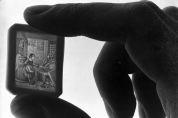Hands Illuminating Porcelain:
The Lithophanes of Hannah Blackwell
Some people have never heard of lithophanes. Others know that lithophanes were first created in Europe in the 1820s and are three-dimensional translucent porcelain plaques which when backlit reveal detailed magical images. Even among the “enlightened” (pun intended), one frequently encounters the belief that this is a lost art form, merely a passing fad from the 19th century, collected by a few astute curators and collectors as curios from our past.
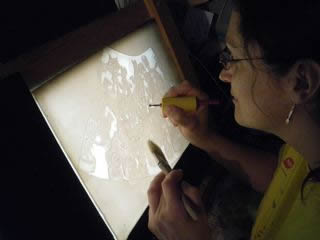
Artist Hannah Blackwell in her Kansas City Art Institute studio in September 2010, carving the wax model for her current project, a lamp created using images of her push puppets collection. It took four weeks to carve the image.
While tens of thousands of lithophanes were manufactured during their heyday by largely European factories between 1840 – 1890, some factories in Germany, Portugal, Ireland, and Hungary have continued manufacturing lithophanes to the present day. Individual studio artists in the United States, the United Kingdom, and elsewhere have been exploring the art of lithophanes for at least the past half-century.
At least some of the current ceramic artists investigating lithophanes, have been drawn to the medium because of the computer technology which allows lithophane models or the porcelain lithophane itself to be carved utilizing CNC machines. Still others are drawn to the original 19th century method of carving wax, creating a plaster mold, then casting and firing porcelain lithophanes.
Outstanding among contemporary lithophane artists, is Hannah Blackwell (American, b. 1971). In 2007, while a student at the Kansas City Art Institute, Hannah saw the work of a fellow student who had made a rudimentary lithophane during a trip to Hungary. She herself then became intrigued by the possibilities. After extensive studies in Hungary in 2008 and 2009, she has since mastered the technique and her beautiful creations will mesmerize viewers.
The Lithophanes of Hannah Blackwell will be on exhibition at the Blair Museum of Lithophanes April 30 through October 30, 2011.
A Conversation with Hannah Blackwell
Through an exchange of emails and phone conversations in August 2010, the artist shared some insights into her life and career choice with Blair Museum curator, Dr. Margaret Carney. Read on if you would like to learn how a woman who was basically given the (bad) advice in high school that “you can’t make a living being an artist,” followed by, “with a degree in art and a quarter, you can buy a cup of coffee,” and drove semis for eleven years could later perfect such a gift.
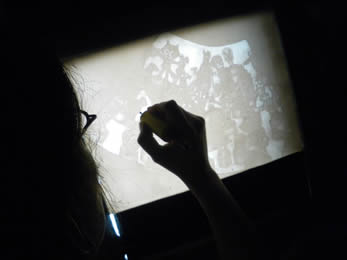
The artist carving one half of the lampshade wax comprised of iconic push puppet images, Kansas City Art Institute, September 2010.
Curator: What sparked your interest in art and becoming an artist?
Hannah: Being the middle child of three siblings, attention was in short supply from a single parent, so when I received positive encouragement for my drawing, I wished and wanted more. After a while I found solace in my art, and a constructive way to exercise my voice.
Curator: When did you first learn about lithophanes?
Hannah: I stumbled across it in 2007. A fellow student (at KCAI) had come back from a trip to Hungary. She had made a rudimentary lithophane and I was struck by the possibilities. This lead me to researching translucent clay bodies online. That’s when I realized this was nothing new, and had a name.
Curator: What factors lead to your decision to study at the Kansas City Art Institute?
Hannah: I had grown up in Kansas City and knew of the Kansas City Art Institute, having taken classes there in high school. I was even accepted there in 1989. However, I believed the bad advice that I was given in high school (about not being able to make a living as an artist...) so I didn’t believe I had a chance to follow my dreams. Many years later (I had been driving a semi truck for eleven years), with positive encouragement and a lot of love all around me, I applied and was accepted as a student at the Kansas City Art Institute.
Curator: Why did you decide to spend time working in Kecskemét, Hungary?
Hannah: This is where the International Ceramic Studio is located, with access to Herend porcelain, one of the most translucent clay bodies in the world. My first visit in 2008 was a month long study abroad program available at KCAI. There I completed my first lithophane. I sculpted it in a ¼ inch slab of slip, the highlights were all over. I felt like I didn’t understand how artisans in the past had generated lithophanes. There were no books or any descriptions as how they made them on the Internet. I felt like this truly was a dead art. In November of 2008, Margaret Carney’s book Lithophanes was published and gave me a good idea how they might have accomplished it in the past. In 2009 I chose to return to ICS for five months.
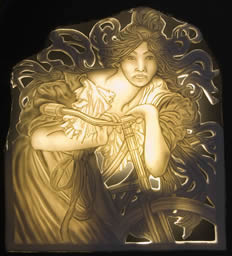
Girl on Bicycle, Hannah Blackwell, March 2009, Herend Porcelain, 11-1/4” x 9-7/8”, created at the International Ceramic Studio, inspired by Alphonse Mucha.
Creating Lithophanes:
Tips from Hannah Blackwell
It is impossible to not ask Hannah for her tips in creating lithophanes.
Curator: Where do you find your inspiration for your lithophanes?
Hannah: All around – Nature, people, situations, it’s endless, being able to succeed at capturing a moment, a feeling. In the wax, it can be magical.
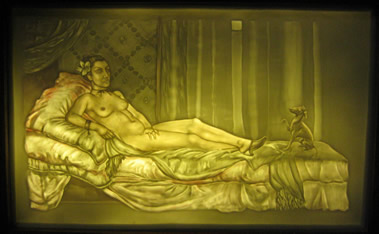
Reclining Nude, Hannah Blackwell, June 2010, Herend Porcelain, colorized, 13-1/4” x 8-1/5”, created at the International Ceramic Studio.
Curator: What materials do you use and/or recommend for making lithophanes?
Hannah: I use wax, which I cast to about ¼” thickness, a light box I custom made, and dental tools. There are a lot of translucent clay bodies, though Laguna Frost is commercially available.
Curator: Why do you color your beeswax for your models?
Hannah: Because as I carve I have a greater ability to see the depth of the lithophane. Without it I found I was more prone to mistakes.
Curator: The Dragon Skin (silicone molding compound) mold you use – what function does it have since you already have the wax model and the plaster mold?
Hannah: It serves as a permanent library of my images – allowing me to recast or rework imagery at a later date, it not being as temperamental as the wax.
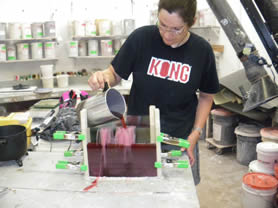
The artist pouring wax slabs between glass panes, allowing her to pour multiples at one time. By using glass she has a perfectly smooth surface for carving. The wax color is arbitrary, as she’s still trying different colors to find the one she most likes to carve. Kansas City Art Institute, July 2010.
Curator: Can you describe the process you use in creating lithophanes?
Hannah: Having cast the wax on glass, I use a light box to render the image. Upon completion, the work will go through a process of mold to casting, silicone to plaster, plaster to plaster, getting back to a positive image and ready to cast in porcelain. After casting there will be a certain amount of clean up. I won’t count any of them as certain until they come out of the kiln. There are so many variables involved in firing lithophanes – cracking, warping, iron spotting, you name it, it could and can go wrong. I have been averaging about 40% success. I have no desire to make 100 of each image. I want each one to be unique. With the four that make it out intact, I will glaze, china paint, luster, and experiment. At the time of this writing I have made seven different lithophanes. I spend about a hundred hours on the large lithophanes.

